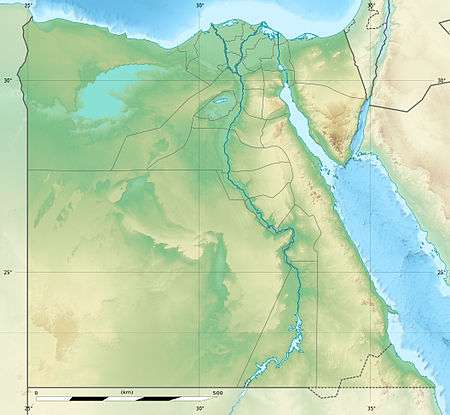1068 Near East earthquake
| Date | March 18, 1068 [1] |
|---|---|
| Magnitude | ≥ 7.0 [2] |
| Epicenter | 29°30′N 34°57′E / 29.5°N 34.95°ECoordinates: 29°30′N 34°57′E / 29.5°N 34.95°E [3] |
| Areas affected | Near East |
| Total damage | Extreme [3] |
| Max. intensity | IX (Violent) [3] |
| Casualties | ~ 20,000 [1] |
The 1068 Near East earthquake occurred on the morning of March 18 in the Near East along the southern portion of the Dead Sea Transform (DST) fault system. The event was responsible for an estimated 20,000 deaths and caused damage in Egypt, the Arabian Peninsula, and other areas east of the Mediterranean Sea. Other strong earthquakes that have occurred on the same southern portion of the DST have also impacted the region.
Geologic setting
The Dead Sea Transform is a 1,000 km (620 mi) transform fault that spans from the Red Sea in the south to the East Anatolian Fault in Turkey to the north. The southern extent of the DST is known as the Wadi Araba fault (after the Arabah valley). This portion of the DST runs 160 kilometers (99 mi) from north of Aqaba to south of the Dead Sea and has a slip rate of 4 ±2 mm per year.[4]
Effects
The earthquake's effects were seen from as far north as Banyas (in the present day coastal region of Syria) to the Hejaz region of modern-day Saudi Arabia. The ancient city of Ayla, located at the northern end of the Gulf of Aqaba where modern Aqaba stands today, was destroyed. Paleoseismic investigations have revealed more than 12 kilometers (7.5 mi) of fault rupture, beginning just north of Eilat, that were dated between 900 and 1,000 years before present. A magnitude of at least 7.0 was presented based on the reported damage and the extent of the observed fault breaks.[2]
Alarm was caused at Saint Catherine's Monastery on the Sinai Peninsula, and there was damage in the ancient city of Tinnis, but not farther to the west along the Egyptian coast in Alexandria. In Cairo the only damage was to a corner of the Mosque of Amr ibn al-As in Fustat. Seismologist Nicholas Ambraseys described one account of the effects at Ramallah as destructive and with a large loss of life (15,000 deaths, several hundred of which were boys at a school). He also expanded on the effects to the north in Banyas, where 100 were killed, and in Jerusalem, where the roof of the Dome of the Rock was "displaced and then returned to its former position". Those that were affected by the heavy damage in Ramallah apparently migrated to Jerusalem, which indicated to Ambraseys that the effects there were otherwise minimal.[5]
Other events
In addition to the event in 1068, the southern portion of the DST has experienced three other historical events (all having an estimated magnitude of 6.5–7.0) with two in the northern section near the Dead Sea, and one closer to Aqaba. The event in 1212 caused significant damage to towns in the Arabah Valley as well as the destruction of a church on the Sinai Peninsula. In 1293, near the southern portion of the Dead Sea, an earthquake destroyed three towers of a castle and caused damage between the Dead Sea and Gaza. In 1458, another event again affected the southern Dead Sea area, this time causing a 2.2 m (7 ft 3 in) left-lateral offset at the Tilah Castle. The castle was built across the fault during Roman or Byzantine times and the building that housed the water tank sustained the displacement.[4]
See also
References
- 1 2 Abdel Fattah, Ali K.; Hussein, Hesham M.; Ibrahim, Ezzeldien M.; Abu El Atta, Ahmad S. (1997), "Fault plane solutions of the 1993 and 1995 Gulf of Aqaba earthquakes and their tectonic implications", Annali di Geofisica, Istituto Nazionale Geofisica e Vulcanologia, XL (6): 1557
- 1 2 Klinger, Y.; Avoua, J. P.; Dorbath, L.; Abou Karaki, N.; Tisnerat, N. (2000), "Seismic behaviour of the Dead Sea fault along the Araba valley, Jordan" (PDF), Geophysical Journal International, Wiley-Blackwell, 142 (3): 772, doi:10.1046/j.1365-246x.2000.00166.x
- 1 2 3 National Geophysical Data Center / World Data Service (NGDC/WDS), Significant Earthquake Database, National Geophysical Data Center, NOAA, doi:10.7289/V5TD9V7K
- 1 2 Yeats, R. (2012), Active Faults of the World, Cambridge University Press, pp. 293, 294, 296, ISBN 978-0521190855
- ↑ Ambraseys, N. N.; Melville, C. P.; Adams, R. D. (2005), The Seismicity of Egypt, Arabia and the Red Sea: A Historical Review, Cambridge University Press, pp. 30, 31, 101, ISBN 978-0521020251
